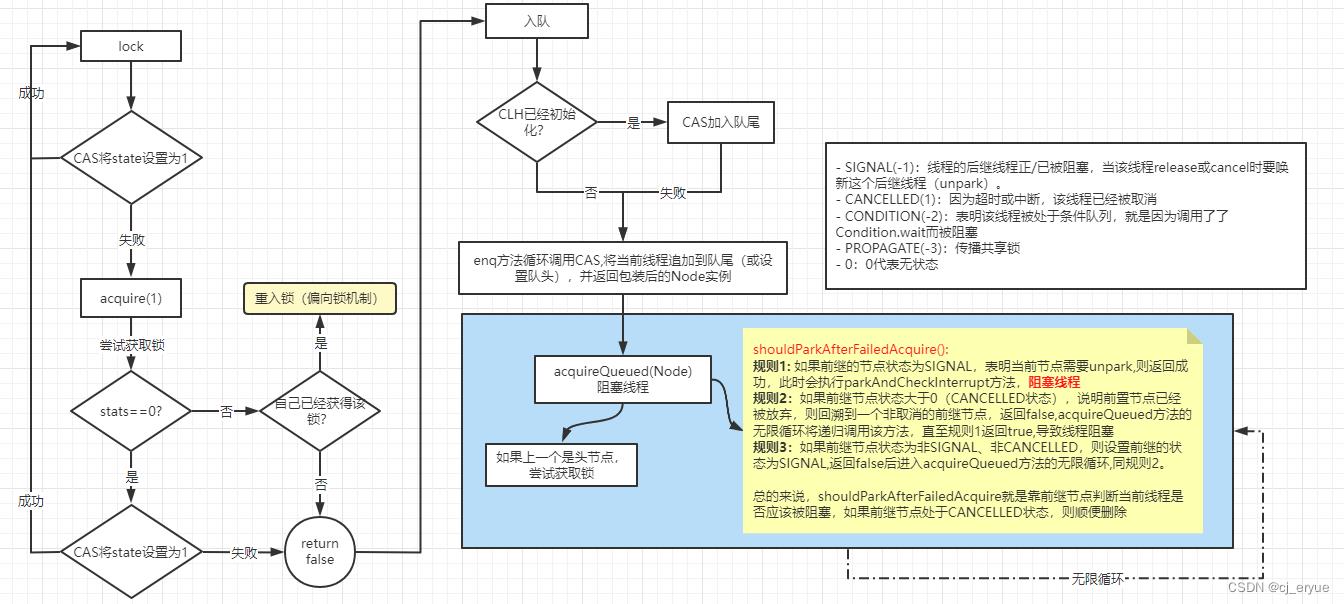二探ReentrantLock非公平锁的加解锁过程
Posted cj_eryue
tags:
篇首语:本文由小常识网(cha138.com)小编为大家整理,主要介绍了二探ReentrantLock非公平锁的加解锁过程相关的知识,希望对你有一定的参考价值。
加锁
ReentrantLock reentrantLock = new ReentrantLock();
reentrantLock.lock();
//...
reentrantLock.unlock();①java.util.concurrent.locks.ReentrantLock#lock
public void lock()
//具体的sync有公平和非公平(默认)两种
sync.lock();
②java.util.concurrent.locks.ReentrantLock.NonfairSync#lock
final void lock()
if (compareAndSetState(0, 1))//这里体现的非公平
setExclusiveOwnerThread(Thread.currentThread());
else
acquire(1);
③java.util.concurrent.locks.AbstractQueuedSynchronizer#acquire
public final void acquire(int arg)
if (!tryAcquire(arg) &&
acquireQueued(addWaiter(Node.EXCLUSIVE), arg))
selfInterrupt();
到这里已经变得复杂了,一个个来分析:
④java.util.concurrent.locks.ReentrantLock.NonfairSync#tryAcquire
protected final boolean tryAcquire(int acquires)
return nonfairTryAcquire(acquires);
⑤java.util.concurrent.locks.ReentrantLock.Sync#nonfairTryAcquire
final boolean nonfairTryAcquire(int acquires)
//获取当前线程
final Thread current = Thread.currentThread();
//获取状态
int c = getState();
//如果为0 ,说明没有线程竞争。通过cas+1,每次线程重入该锁都会+1,释放都会-1,为0时释放锁。如果cas设置成功,则可以预计其它线程cas都是失败的,也就认为当前线程得到了锁,作为Running线程
if (c == 0)
if (compareAndSetState(0, acquires))
setExclusiveOwnerThread(current);
return true;
//如果c!=0,但是自己已经拥有锁,则只是简单的执行+1,并修改status值,因为没有竞争,所以直接通过setStat修改,而非cas,也就是说这里实现了偏向锁的功能!
else if (current == getExclusiveOwnerThread())
int nextc = c + acquires;
if (nextc < 0) // overflow
throw new Error("Maximum lock count exceeded");
setState(nextc);
return true;
return false;
如果返回fasle,我们来看下步骤③中的acquireQueued(addWaiter(Node.EXCLUSIVE), arg) 方法:
addWaiter方法负责把当前无法获得所锁的线程包装成Node添加到CLH队尾,mode参数表示是独占锁还是共享锁:
static final class Node
/** Marker to indicate a node is waiting in shared mode */
static final Node SHARED = new Node();
/** Marker to indicate a node is waiting in exclusive mode */
static final Node EXCLUSIVE = null;
private Node addWaiter(Node mode)
Node node = new Node(Thread.currentThread(), mode);
// Try the fast path of enq; backup to full enq on failure
Node pred = tail;
//如果当前队尾已经存在,则使用cas把当前线程更新为Tail
if (pred != null)
node.prev = pred;
if (compareAndSetTail(pred, node))
pred.next = node;
return node;
//如果当前Tail为null或者使用cas把当前线程更新为Tail失败,则通过enq方法继续设置Tail
enq(node);
return node;
private Node enq(final Node node)
//循环调用CAS,将当前线程追加到队尾(或设置队头),并返回包装后的Node实例。
for (;;)
Node t = tail;
if (t == null)
// Must initialize
if (compareAndSetHead(new Node()))
tail = head;
else
node.prev = t;
if (compareAndSetTail(t, node))
t.next = node;
return t;
把线程包装成Node对象的主要原因为除了用Node供虚拟队列用外,还用Node包装了各种线程状态:
/** waitStatus value to indicate thread has cancelled */
static final int CANCELLED = 1;
/** waitStatus value to indicate successor's thread needs unparking */
static final int SIGNAL = -1;
/** waitStatus value to indicate thread is waiting on condition */
static final int CONDITION = -2;
/**
* waitStatus value to indicate the next acquireShared should
* unconditionally propagate
*/
static final int PROPAGATE = -3;-
SIGNAL(-1):线程的后继线程正/已被阻塞,当该线程release或cancel时要唤新这个后继线程(unpark)。
-
CANCELLED(1):因为超时或中断,该线程已经被取消
-
CONDITION(-2):表明该线程被处于条件队列,就是因为调用了了Condition.wait而被阻塞
-
PROPAGATE(-3):传播共享锁
-
0:0代表无状态
接着看acquireQueued,acquireQueued的主要作用是把已经追加到队列的线程节点(addWaiter方法返回值)进行阻塞,但阻塞前又通过tryAccauire重试是否能获得锁,如果重试成功则无需阻塞了,直接返回:
final boolean acquireQueued(final Node node, int arg)
boolean failed = true;
try
boolean interrupted = false;
for (;;)
final Node p = node.predecessor();
//这里是个无限循环,但是不会出现死循环,原因在于parkAndCheckInterrupt会把当前线程挂起,从而阻塞住线程的调用栈
if (p == head && tryAcquire(arg))
setHead(node);
p.next = null; // help GC
failed = false;
return interrupted;
if (shouldParkAfterFailedAcquire(p, node) &&
parkAndCheckInterrupt())
interrupted = true;
finally
if (failed)
cancelAcquire(node);
private final boolean parkAndCheckInterrupt()
LockSupport.park(this);
return Thread.interrupted();
private static boolean shouldParkAfterFailedAcquire(Node pred, Node node)
int ws = pred.waitStatus;
if (ws == Node.SIGNAL)
//规则1:如果前继的节点状态为SIGNAL,表明当前节点需要unpark,则返回成功,此时会执行parkAndCheckInterrupt方法,阻塞线程
return true;
if (ws > 0)
//规则2:如果前继节点状态大于0(CANCELLED状态),说明前置节点已经被放弃,则回溯到一个非取消的前继节点,返回false,acquireQueued方法的无限循环将递归调用该方法,直至规则1返回true,导致线程阻塞
do
node.prev = pred = pred.prev;
while (pred.waitStatus > 0);
pred.next = node;
else
//规则3:如果前继节点状态为非SIGNAL、非CANCELLED,则设置前继的状态为SIGNAL,返回false后进入acquireQueued方法的无限循环,同规则2
compareAndSetWaitStatus(pred, ws, Node.SIGNAL);
return false;
总的来说,shouldParkAfterFailedAcquire就是靠前继节点判断当前线程是否应该被阻塞,如果前继节点处于CANCELLED状态,则顺便删除。

至此,锁住线程的逻辑已经分析完成,下面讨论下解锁的过程。
解锁
请求锁不成功的线程会在acquireQueued方法中的parkAndCheckInterrupt方法里挂起,之后的代码必须等线程被解锁才能执行,假如现在线程被解锁,则执行interrupted = true;,之后又进入acquireQueued的无限循环。
但是得到解锁的线程不一定能获得锁,必须通过调用tryAcquire重新竞争,因为锁是非公平的,有可能被新加入的线程获得,从而导致刚被唤醒的线程再次被阻塞,这里充分体现了非公平机制
①java.util.concurrent.locks.ReentrantLock#unlock
public void unlock()
sync.release(1);
②java.util.concurrent.locks.AbstractQueuedSynchronizer#release
public final boolean release(int arg)
if (tryRelease(arg))
Node h = head;
if (h != null && h.waitStatus != 0)
unparkSuccessor(h);
return true;
return false;
//第一个可以unpark的线程,一般来说head.next == head,head就是第一个线程,但是head.next可能被取消或置为null,因此最稳妥的办法就是从后往前找第一个可用线程
private void unparkSuccessor(Node node)
/*
* If status is negative (i.e., possibly needing signal) try
* to clear in anticipation of signalling. It is OK if this
* fails or if status is changed by waiting thread.
*/
int ws = node.waitStatus;
if (ws < 0)
compareAndSetWaitStatus(node, ws, 0);
/*
* Thread to unpark is held in successor, which is normally
* just the next node. But if cancelled or apparently null,
* traverse backwards from tail to find the actual
* non-cancelled successor.
*/
Node s = node.next;
if (s == null || s.waitStatus > 0)
s = null;
for (Node t = tail; t != null && t != node; t = t.prev)
if (t.waitStatus <= 0)
s = t;
if (s != null)
LockSupport.unpark(s.thread);
如果释放锁成功,则唤醒队列的第一个线程Head
protected final boolean tryRelease(int releases)
int c = getState() - releases;
if (Thread.currentThread() != getExclusiveOwnerThread())
throw new IllegalMonitorStateException();
boolean free = false;
if (c == 0)
free = true;
setExclusiveOwnerThread(null);
setState(c);
return free;
tryRelease作用很明确,如果线程多次锁定,则进行多次释放,直至status==0则真正释放锁,即将status设置为0,因为无竞争,所也没有使用CAS。
Lock Vs Synchronized
AbstractQueuedSynchronizer通过构造一个基于阻塞的CLH队列容纳所有的阻塞线程,而对该队列的操作均通过Lock-Free(CAS)操作,但对已经获得锁的线程而言,ReentrantLock实现了偏向锁的功能。 Synchronized的底层也是一个基于CAS操作的等待队列,但JVM实现的更精致,把等待队列分为ContentionList和EntryList,目的是为了降低现成的出列速度,当然也实现了偏向锁,从数据结构来说二者设计没有本质区别,但Synchronized还实现了自旋锁,并针对不同的系统和硬件体系进行了优化,而Lock则完全依靠系统阻塞挂起等待线程。
当然Lock比Synchronized更适合在应用层拓展,可以继承AbstractQueuedSynchronizer定义各种实现,比如实现读写锁(ReentrantReadWriteLock)、公平或不公平锁;同时,Lock对应的Condition也比wait/notify要方便、灵活的多!
以上是关于二探ReentrantLock非公平锁的加解锁过程的主要内容,如果未能解决你的问题,请参考以下文章